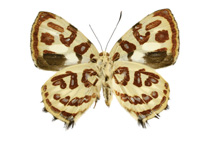Abstract
Three new species of Anteros Hübner, [1819] from south and southeastern Brazil are described: A. aliceae Dias & Siewert, sp. nov., A. zikani Siewert, Dias & Dolibaina, sp. nov. and A. ethani Dias, Dolibaina & Mielke, sp. nov. Habitus and genitalia of male and female specimens of the new species are illustrated, along with illustrations of the habitus and male genitalia of the most similar species for proper distinction. The following taxonomic changes are proposed: A. micon Druce, 1875, stat. rest., A. roratus Godman & Salvin, 1886, stat. rest., and A. theleia Stichel, 1910, stat. nov. Anteros formosus stramentarius Stichel, 1909, syn. nov. is sunk as a junior subjective synonym of A. formosus. Additionally, Ourocnemis axiochus (Hewitson, 1867), stat. rest., is recognized as a species distinct from O. archytas (Stoll, 1787); illustrations of the male genitalia and of the differential characters of the wing pattern of both species are provided. A male of the rare Ourocnemis boulleti Le Cerf, 1911, is reported from southeastern Peru. Distributional data and a map are provided for all species studied.

